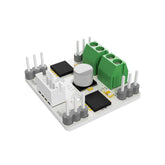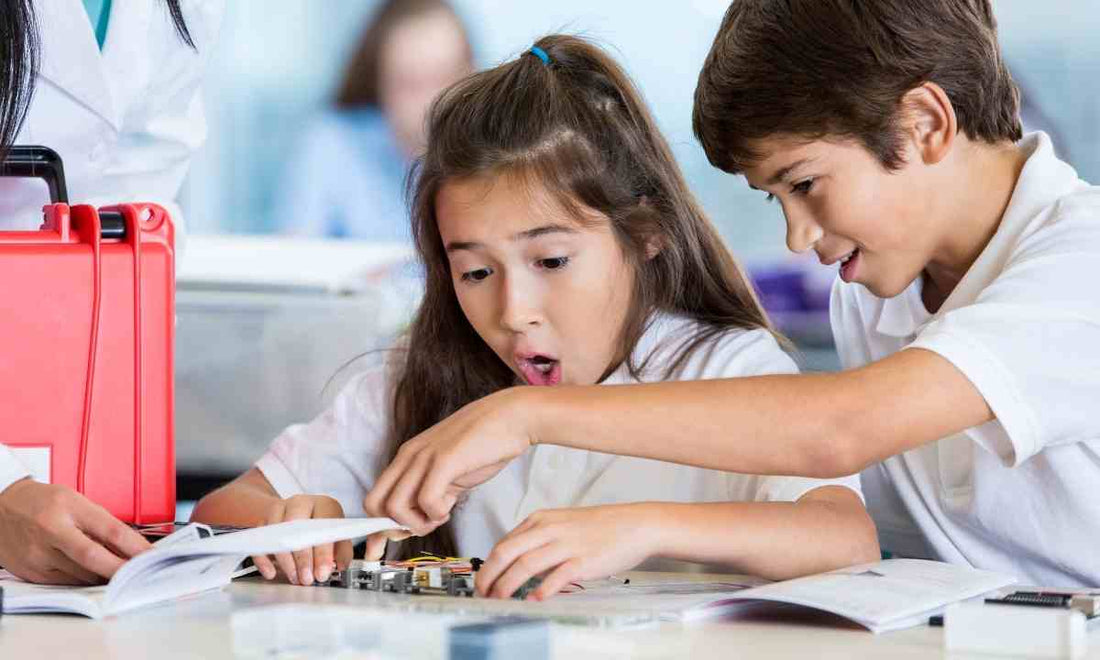Incorporate STEM into Classrooms with Examples
Table of Contents
If you are reading this article, it means you already know what STEM is. So, I won't explain it again.
However, even though we know what STEM is, it seems we haven't fully grasped its importance.
STEM is an educational method that covers the most important topics of the future. This method, which includes various branches such as mathematics, technology, science, and robotics education, is actually what we owe almost everything we see around us.
Even when peeling a potato, it's possible to see the traces of STEM. STEM endows individuals with the ability to question and be aware, as well as the skill to solve problems.
Think about the inventors of the potato peeler.
They first realized how difficult it was to peel potatoes with a knife. They also noticed that a lot of the potato was wasted when peeled with a knife.
Then they sought a solution. They wanted to develop a product that was as sharp as a knife and as delicate as a bird's wing.
Additionally, they realized it needed to have an ergonomic handle for easy gripping.
As a result, it didn't take long for them to invent the potato peeler that is in everyone's home today.
Each of these stages happens within the scope of STEM education.
Yes, perhaps the exact concept of STEM education wasn't known in the past, but still, human intelligence has always known the importance of this type of education throughout history.
In today's modern world, this educational model is systematically carried out. It occupies an important place in the educational curricula of many countries. And its importance is increasing day by day.
So, let's answer this important question:
How to Incorporate STEM in the Classroom?
Teachers can integrate STEM learning into classroom curriculum by:
- Implementing hands-on, project-based learning activities.
- Encouraging problem-solving and critical thinking through real-world challenges.
- Incorporating technology and digital tools in lessons.
- Connecting math, science, and engineering concepts in interdisciplinary teaching.
- Promoting inquiry-based learning and independent research.
- Utilizing external resources like guest speakers and field trips.
- Encouraging teamwork and collaboration in group projects.
- Diversifying assessment methods beyond traditional tests.
- Using educational games and simulations for interactive learning.
- Staying updated with the latest STEM developments and teaching methods.

If we were to explain all these points step by step;
1. Help Your Students Gain Inquiry Skills
Before starting a comprehensive STEM education, the first issue you need to address is instilling the ability to inquire in your students. STEM is not an education one can receive without having the ability to inquire.
Imagine, no matter how much you teach mathematics or science to a person without the ability to inquire, they won't be able to use that knowledge effectively.
For example, you told a person about the valuable minerals on the moon's surface. If they do not question what these minerals are used for or how they can be extracted, this information will be forgotten in a month and become useless.

What are some easy activities you can do in the classroom to develop inquiry skills?
Essentially, you can do anything that involves a problem. For example, if your classroom's whiteboard is very dirty, you could turn to your students and ask, "How can I clean this board without an eraser?" and then apply the most favored answer. Even this is an activity that will develop inquiry skills.
If you need more easy activity suggestions to develop inquiry skills:
-
Hypothesis Testing: Have students make observations and form hypotheses. Then, ask them to test these hypotheses with simple experiments, like observing how plants grow in light.
-
Question Time: At the beginning or end of each lesson, ask students to pose at least one question related to the topic. These questions can be discussed in later parts of the lesson.
-
Solving Puzzles: Present students with puzzles or problems and encourage them to discuss solutions. This develops critical thinking and creative problem-solving skills.
-
Observation Journal: Have students keep an observation journal, where they record and write about events they observe and things they are curious about.
-
Research Projects: Allow students to conduct short research projects on topics they are interested in and present their findings in front of the class.
-
Role-Playing Activities: Organize role-playing activities about historical events or scientific processes. Having students act out these events or processes creates opportunities for in-depth understanding and inquiry.
-
Creating Mind Maps: Ask students to create mind maps about a topic. This helps them organize their thoughts and make connections.
-
Research Projects: Encourage students to conduct short research projects on topics they are interested in. Ask them to present their findings in front of the class.
-
Role-Playing Games: Organize role-playing activities about historical events or scientific processes. Having students act out these events or processes provides deep understanding and inquiry opportunities.
-
Creating Mind Maps: Ask students to create mind maps on a topic. This helps them organize their thoughts and establish connections.
-
Classroom Discussions: Arrange discussions that allow students to express different opinions and question each other's ideas.
-
Analyzing Daily Events: Bring daily news or events to class and ask students to analyze these events with questions.
-
Creative Writing Activities: Encourage students to write stories using their imagination or create alternative endings to existing stories.
2. Conduct Interdisciplinary Teaching
As mentioned earlier, STEM is a very comprehensive education model.
Interdisciplinary education allows you to teach all its scope.
For example, you are teaching a lesson on Sustainable Urbanization.
This topic involves geography, environmental science, sociology, economics, and engineering disciplines.
-
Geography: Students examine the geographic locations of different cities and how these locations impact urban planning.
-
Environmental Science: The environmental aspects of sustainable urbanization are discussed. Students learn about topics such as the conservation of green spaces, waste management, and energy efficiency.
-
Sociology: The social structures in cities, migration movements, demographic changes, and their effects on urban life are examined.
-
Economics: The economic aspects of sustainable urbanization are analyzed through cost and investment analysis in urban development.
-
Engineering: The design and construction of sustainable buildings and infrastructure projects, energy-efficient transportation systems, and other topics are evaluated from an engineering perspective.

This interdisciplinary approach provides students with a comprehensive perspective on sustainable urbanization, not just a single aspect, through various scientific disciplines. This enables students to evaluate the topic from a broader perspective and develop critical thinking skills.
3. Conduct Teamwork Activities
After all these gains, conducting teamwork activities is a fun way to reinforce these learnings in students' minds.
Also, team projects can present more challenges for students. Solving these as a team helps them succeed in teamwork in the future.
For example, let's turn the "Sustainable Urbanization" topic mentioned above into a team project;

Project Name: "Designing Our Sustainable City"
Groups and Their Tasks:
-
Geography and Environmental Science Group: This group selects the geographic location of the city and analyzes its environmental impacts. They plan the city's green areas, water resources, and eco-friendly energy usage.
-
Sociology and Demography Group: This team studies the city's social structure and population distribution. They develop social policies considering migration, education, health services, and social welfare.
-
Economics and Finance Group: This group forms the city's economic model and development plan. They work on investment costs, economic sustainability, and job opportunities.
-
Engineering and Infrastructure Group: This team designs the city's infrastructure and buildings. They develop projects on energy-efficient buildings, transportation networks, and waste management systems.
Activity Flow:
-
Research and Planning: Each group conducts research related to their field and creates a plan.
-
Inter-Group Collaboration: Groups share their plans with each other and discuss how different aspects of the city can integrate with each other.
-
Joint City Design: The groups combine their information and plans to create a joint city design.
-
Presentation: Each group presents their work and the overall design of the joint city to the class.
-
Evaluation and Feedback: Teachers and other students provide feedback on the presented projects.
This team project shows students the importance of interdisciplinary collaboration while also developing their problem-solving, creativity, and teamwork skills.
4. Conduct STEM-Focused Exams in Addition to Traditional Exams
We all know traditional exams. A paper is given. Questions are written on the paper, and students answer them in writing.
In addition to these exams, try to conduct STEM-focused exams.
We can give an example by turning the "Sustainable Urbanization" topic mentioned above into a STEM-focused exam.
Part 1: Individual Knowledge and Application Test
- Duration: 30 minutes
- Content: Each student receives multiple-choice and short-answer questions related to STEM fields (Science, Technology, Engineering, Mathematics). The questions measure students' basic knowledge of sustainable urbanization, understanding, and application skills.
Part 2: Group Project Presentation and Defense
- Duration: 15 minutes presentation for each group, 10 minutes of Q&A
- Content: Each group presents their "Designing Our Sustainable City" project. The presentation should cover all aspects of the project (geography, environmental science, sociology, economics, engineering).
- Q&A Section: After the presentation, questions related to the project are posed to group members by the teacher and classmates.
Part 3: Practical Problem-Solving Activity
- Duration: 45 minutes
- Content: Students are given a scenario related to sustainable urbanization. They work in groups to solve the problems encountered in the scenario and develop practical solutions.
Evaluation Criteria:
- Knowledge Understanding: The accuracy and depth of students' basic knowledge in STEM subjects.
- Application Skill: The ability to apply theoretical knowledge to real-world scenarios.
- Teamwork and Collaboration: Interaction, collaboration, and collective effort within the group.
- Creativity and Innovation: The ability to bring creative and innovative solutions to problems.
- Presentation Skills: Communication skills during the project presentation and the ability to clearly express their ideas.

This exam comprehensively evaluates students' individual and group STEM skills as well as their knowledge and application abilities in sustainable urbanization.
5. Purchase Classroom STEM Kits
Many stages of STEM education are low cost. However, some investments are necessary for advanced studies.
For example, learning robotics coding, an important branch of STEM, completely for free will be difficult and insufficient.
Therefore, purchasing a comprehensive classroom kit for in-class activities will be beneficial.
At this stage, let me introduce the Classroom Kit: STEM Robotics Kits For Schools developed by our R&D and STEM education team.

This kit is very comprehensive. It is powered by the frequently used Raspberry Pi Pico W in education and industry.
It includes 11 of the most used components in robotics coding along with extensions to build a smart greenhouse, voice-controlled car, and robot arm.
Moreover, it also includes a comprehensive Teacher's guide explaining how to conduct STEM activities in the classroom.
You can also request a sample PicoBricks Kit for free from us.
Free STEM kits Request for teacher
6. Follow the Curricula of Ministries of Education
Many countries place great importance on STEM education. Below, I am leaving for you some STEM curricula from various universities and ministries.
I hope all this has been useful for you, esteemed teachers.
How to incorporate stem in the classroom, our article ends here.
If you have any questions, we would be pleased to answer them. See you in another article.
Stay healthy!





